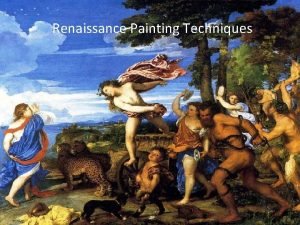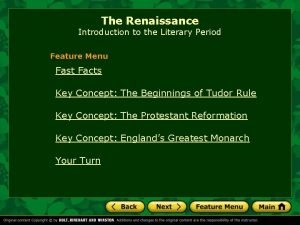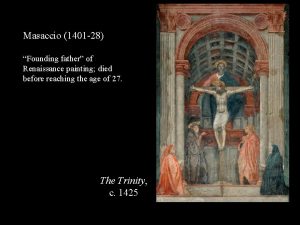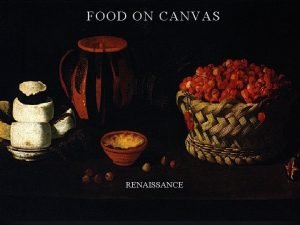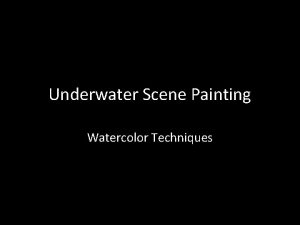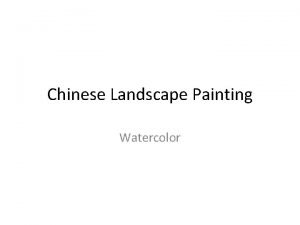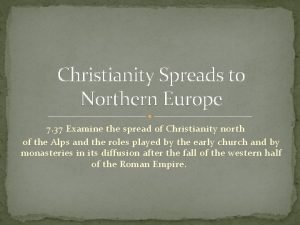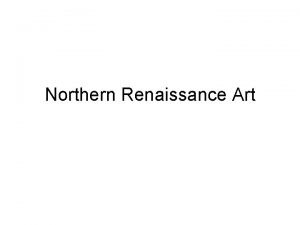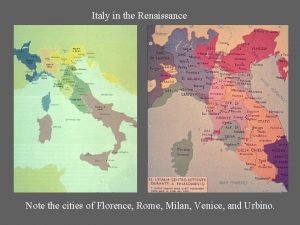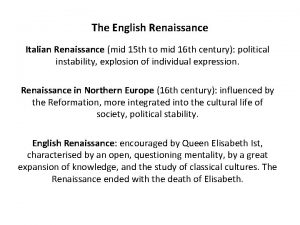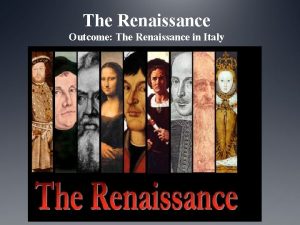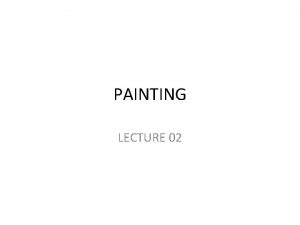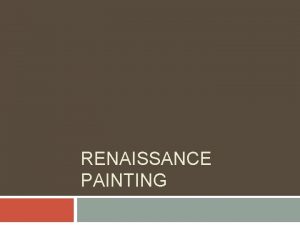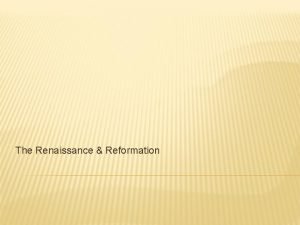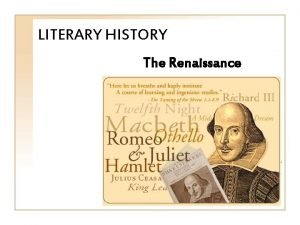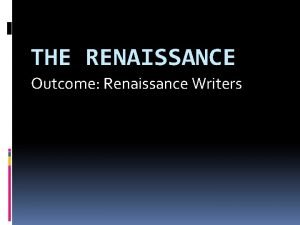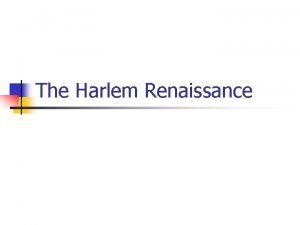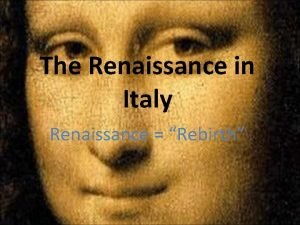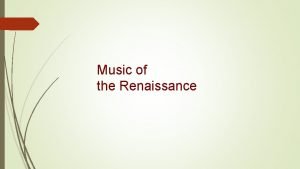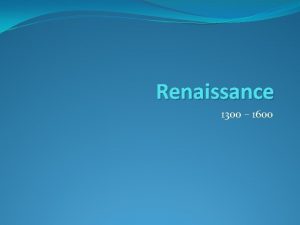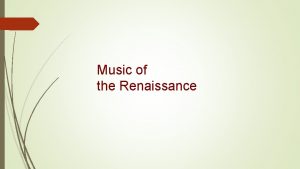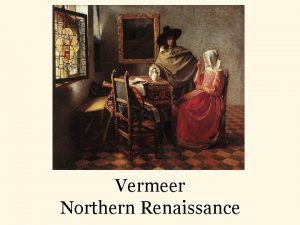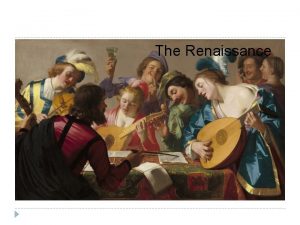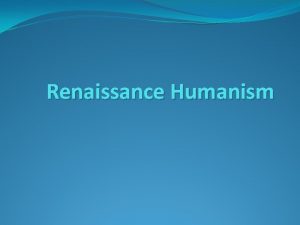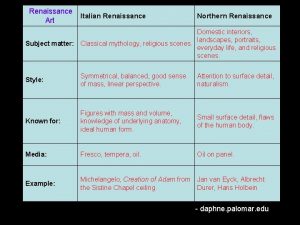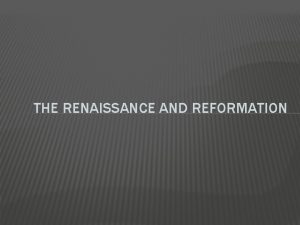Renaissance Painting Techniques Renaissance Painting Techniques Introduction The































- Slides: 31

Renaissance Painting Techniques

Renaissance Painting Techniques Introduction: The Golden Key Since time began artists have been obsessed with the idea of the golden key a specific piece of knowledge that will unlock the mysteries of painting. Artists, authors, and historians have claimed the discovery of the supposed key to a formulation to execute sublime paintings effortlessly. T he mastery to painting effortlessly. Realistically, it is wishful thinking although pathways have provided partial answers. However, the idea still persists and painters still seek a simple solution. Attributed to Baccio Baldini, Mercury (c. 1464), engraving, 324 x 218 mm.

Methods & Materials Renaissance Painting Techniques: The Renaissance (rebirth) was a revolutionary period of world history where Science & Art combined with a powerful thirst for learning, became known as the intellectual movement of the humanists. The culmination of these disciplines fused a new visualization of the world. Painting, Sculpture & Architecture played an important role. In the visual arts, three main painting mediums proved to be prevalent in the Early & High Renaissance. Fresco, Egg tempera and Oil painting. Michelangelo’s Creation of Adam (Fresco)

Methods & Materials The four canonical painting modes of Renaissance Painting; Chiaoscuro- “light-dark” Term relating to light & dark contrasts in a composition. Dramatic effect Cangiante- The changes in hue of a colour in shadow or highlights. Sfumato- Absence of hard lines or edges around the images. A soft diffused effect with a natural gradation from light to dark. Unione-Similar in effect to Sfumato except the colour saturation is much higher. Greater intensity of colour with a naturalistic approach. Michelangelo’s Creation of Adam (Fresco)


Methods & Materials Egg Tempera The egg tempera painting technique was the main method of applying paint to panel throughout the early Renaissance. The pigment is mixed with egg, using the white of the egg or the yolk results in different effects, the mixture is fast drying and permanent. Tempera has been discovered on early Egyptian decorations and the painting technique was also used throughout the Byzantine period. The fourteenth century, or Trecento, took inspiration from classical Greek and Roman sculptors. Detail of Botticelli’s Birth of Venus 172. 5 cm × 278. 5 cm

Methods & Materials Egg Tempera Typically a wooden panel was prepared by covering the surface with layers of gesso made with gypsum mixed with animal glue and worked into a thick paste. (gesso grosso) 1. A wooden panel is sealed with size or strips of linen to cover any joints or knots in the wood. 1. The panel is coated with layers of gesso, up to eight coats may be applied.

Methods & Materials Egg Tempera The panel would then be finished in a smooth covering of gesso, the gesso sottile. This would be the consistency of double cream when applied on top the gesso grotto. The final gesso surface is then polished to the smooth, brilliant white consistency ready for the application of paint. 3. The artist would typically outline the composition using the pouncing method and then the design would be defined in paint. 4. An under-painting is then applied followed by an over-painting until completed.

Methods & Materials Egg Tempera Most artists would transfer a drawing (cartoon) to the surface using the pouncing method. This is the technique of puncturing holes into the lines of the drawing. The paper was then laid onto the gesso ground and dusted with charcoal powder. The charcoal penetrated through the holes leaving a series of dots on the gesso. From this the artist was able to outline the final composition of the painting.

Raphael, A Knights Dream. c. 1504. Tempera on wood. National Gallery London.


Methods & Materials Renaissance Painting Techniques Fresco (fresh) Examples of fresco painting techniques date back to at least 1500 BC. The use of the medium became very prominent in the Medieval & Renaissance periods. The Buon (wet) and Secco (dry) techniques were commonly used for Fresco painting. It is essentially binding coloured pigment into plaster to create a very permanent image. The vault of the Sistine Ceiling covers 800 sqm of fresco painting. Michelangelo’s Sistine Chapel - Commissioned by Pope Julius II. The painting took four years to complete 1508 -1512.

Methods & Materials Fresco True Fresco or Buon fresco consists of applying pigment & brush painting onto freshly applied, wet lime plaster (referred to as the intonaco. ) Using water as the medium the paint is absorbed into the plaster as it dries and the pigment is bound into the structure of the plaster. Giotto’s Adoration of the Magi -the artist has used both the Buon & Secco techniques in this Fresco painting.

Methods & Materials Secco fresco is used on dry plaster, pigment is applied using egg or size as the medium and also as a binder for the paint. The secco fresco technique the paint is not absorbed into the structure of the plaster. It forms a surface layer which tends to flake therefore it is not permanent as Buon fresco. Secco fresco is often used in conjunction with the buon method, secco is faster and allows for mistakes to be corrected. Giotto’s Flight into Egypt -the artist has used both the Buon & Secco techniques in this Fresco painting.

Methods & Materials Fresco A third type of fresco, mezzofresco(semi–dry) common at the end of the sixteenth century. An intonaco was applied & painted when the surface was almost dry. The pigment slightly penetrates the surface of the plaster retaining much of the colour that varied considerably when painting into wet plaster. Michelangelo-Separation of Land & Water Sistine Chapel

Methods & Materials Fresco Typically the artist would work from a top corner of the painting and gradually apply the paint from top to bottom, working a stage each day until completion. This method avoided damaging or splattering finished sections with paint. 1. A textured base layer of plaster called the arriccio was applied to the wall and allowed to dry. 1. The artist then laid further plaster for a single days work, a preparatory drawing of red pigment, the sinopia was then applied onto the intonaco.

Methods & Materials Fresco The area to be painted was first covered with an under layer of plaster named the arriccio. Often the artists would sketch their compositions on intonaco in a red pigment called sinopia. To make changes to the composition was difficult due to the drying time of the plaster. (about 8 or 9 hours). 3. Further painting was added each day. 4. Finally the work was completed.


Methods & Materials Oil Painting The oil painting technique was to become dominant in the 15 th and 16 th centuries, it has remained as the artists favourite medium only being challenged in the latter years of the twentieth century by the advent of acrylic paint. Artists working in tempera found that their colours lacked the covering power of oils while the fresco found it difficult to make alterations to his work. David with Head of Goliath Caravaggio-1601

Methods & Materials Oil Painting During the early Renaissance period oil painting was used first by the Dutch painters and was eventually taken up by their counterparts in Italy. Oil provided a versatile medium in which the artist was allowed the freedom to change the composition of his painting. Colour saturation of the paint was enhanced by the use of oil, no other medium could reproduce it's range of both transparency and opacity. David with Head of Goliath Caravaggio- 1601

Methods & Materials Oil Painting The oil painting technique was to become dominant in the 15 th and 16 th centuries. The Northern painters preparation used oak panels (or other timbers) with smooth, white chalk grounds. A detailed under drawing was then added and usually made none absorbent by the application of a drying oil. Sometimes known as a n isolating varnish. Titian-Self Portrait c. 1567 oil on canvas-Madrid

Methods & Materials Oil Painting: (Northern Art) 15 th Century Technique circa: -1436. A wooden panel would be used typically made from oak. The panel would be covered with an animal skin glue then a chalk ground would be polished into a smooth layer. The white ground would often play an important role in the luminosity of the finished work

Methods & Materials Oil Painting: 15 th Century Technique circa: -1436. (Northern Art) Northern artists applied a very detailed under drawing or painting using a fine brush and fluid, thin paint. Importantly the technique allowed for alterations to be made as the work progressed. The painting was completed using several layers of paint working from light to dark tones. Very detailed finished work in contrast to the freer brush strokes of later renaissance works. Descent from the Cross Rogier van der Weyden

Methods & Materials 16 th Century Technique circa: -1562. (Italian Art) The introduction of canvas as a support for oil paints allowed for easier transport of larger compositions, canvas is far lighter that oak panels. Canvas became prominent in the Italian renaissance and it was widely used particularly in Venice. In fine art linen is still considered to be the finest support for oil painting. In 1523 the great artist Titian painted his Bacchus and Ariadne, Oil on canvas 176. 5× 191 cm. National Gallery, London. (s)

Methods & Materials Oil Painting: 16 th Century Technique circa: -1562. (Italian Art) A linen canvas was used was stretched and sized. The Size sealed & protected the fibres of the canvas by making them less absorbent this prevented the oil from making them brittle. A smooth gesso ground made from animal skin glue and gypsum was applied. This thin coating just covered the gaps in the weave.

Methods & Materials Oil Painting: 16 th Century Technique circa: -1562. (Italian Art) Titian painted freely onto the canvas sketching out his composition in broad brush strokes and blocking in the main areas. The under painting is a part of the final composition and not just a framework for the main elements of the painting. Titian used any method necessary to achieve his goals even using his fingers or the back of his brush to work in the paint.

Methods & Materials Oil Painting: 16 th Century Technique circa: -1562. (Italian Art) Thinner paint is used in the shadows and the highlights are generally painted in thick opaque paint mixed with generous amounts of white lead pigment. There are no hard outlines in this work, the flesh tone are carefully modelled.


Methods & Materials Glossary of terms: Arriccio- The under or base layer of plaster before applying the intonaco. Binder- An ingredient of paints, pastels or grounds (gum, oil etc. ) that holds the materials together and adheres to the paint surface. Buon Fresco or True Fresco (wet)- Applying pigment & brush painting onto freshly applied, wet lime plaster. Cangiante- The changes in hue of a colour in shadow or highlights. Colour saturation- A colour that appears rich & glowing, the use of pure colour as opposed to tints or shades. Cartoon- Drawing prepared for the finished painting worked in detail before transferring to the paint surface or support. Chiaoscuro- “light-dark” Term relating to light & dark contrasts in a composition. Gesso grosso- Gypsum mixed with animal glue and worked into a thick paste. Gesso sottile- This would be a very smooth gesso when applied on top of the gesso grotto. Ground- A foundation layer that acts as a barrier between the support & the painting

Methods & Materials Glossary of terms: Medium- A substance such as oil, gum, egg mixed with pigment to form paint it also refers to formulations to manipulate the handling of the paint to achieve a specific finish. Mezzo-fresco(semi–dry) An intonaco was applied & painted when the surface was almost dry. Secco Fresco (dry) - Pigment is applied using egg or size as the medium and as a binder for the paint onto dry plaster. Sfumato- Absence of hard lines or edges around the images. A soft diffused effect with a natural gradation from light to dark. Sinopia- A red pigment used to transfer drawings onto the intonaco. Size- A weak solution of glue usually animal or gelatine to impregnate and act as a stabilizer , protective layer & means to control absorbency. Support- The surface on which the size and/or ground is applied i. e. , wood panel, canvas, metal etc. Pounce- To press powdered charcoal through the holes in a cartoon to transfer a drawing to the ground. Unione-Similar in effect to Sfumato except the colour saturation is much higher. Greater intensity of colour with a naturalistic approach.

-FIN
 Renaissance art techniques
Renaissance art techniques The renaissance introduction to the renaissance answer key
The renaissance introduction to the renaissance answer key Who is the father of renaissance art?
Who is the father of renaissance art? Beneath the american renaissance
Beneath the american renaissance Renaissance painting food
Renaissance painting food Underwater scene painting
Underwater scene painting Scenic painting techniques
Scenic painting techniques It involves the same techniques as in traditional painting
It involves the same techniques as in traditional painting Introduction painting
Introduction painting Causes of renaissance
Causes of renaissance Italian renaissance vs northern renaissance venn diagram
Italian renaissance vs northern renaissance venn diagram The renaissance outcome renaissance painters/sculptors
The renaissance outcome renaissance painters/sculptors Italian vs northern renaissance
Italian vs northern renaissance Last supper labeled
Last supper labeled Italian renaissance vs english renaissance
Italian renaissance vs english renaissance The renaissance outcome the renaissance in italy
The renaissance outcome the renaissance in italy Hát kết hợp bộ gõ cơ thể
Hát kết hợp bộ gõ cơ thể Frameset trong html5
Frameset trong html5 Bổ thể
Bổ thể Tỉ lệ cơ thể trẻ em
Tỉ lệ cơ thể trẻ em Voi kéo gỗ như thế nào
Voi kéo gỗ như thế nào Chụp tư thế worms-breton
Chụp tư thế worms-breton Alleluia hat len nguoi oi
Alleluia hat len nguoi oi Môn thể thao bắt đầu bằng từ đua
Môn thể thao bắt đầu bằng từ đua Thế nào là hệ số cao nhất
Thế nào là hệ số cao nhất Các châu lục và đại dương trên thế giới
Các châu lục và đại dương trên thế giới Công của trọng lực
Công của trọng lực Trời xanh đây là của chúng ta thể thơ
Trời xanh đây là của chúng ta thể thơ Mật thư tọa độ 5x5
Mật thư tọa độ 5x5 101012 bằng
101012 bằng độ dài liên kết
độ dài liên kết Các châu lục và đại dương trên thế giới
Các châu lục và đại dương trên thế giới
